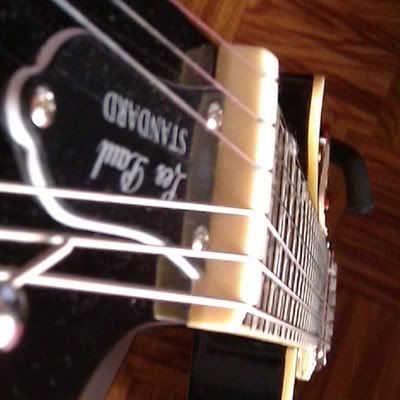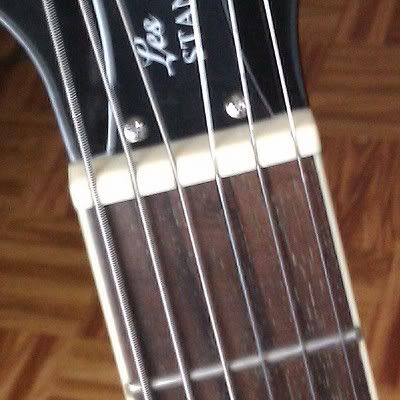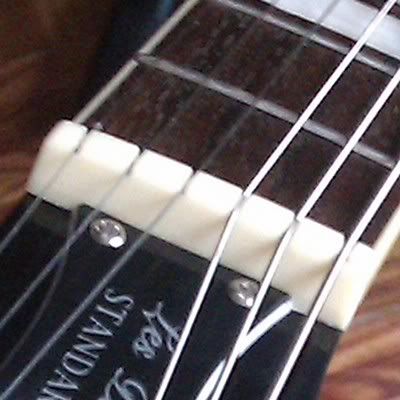Today I restrung my Les Paul with a set of 11-52. I was using 10-46 lately and I also used a couple of 9-42 sets when I bought the guitar. While I was tuning the 6th string, the nut broke (the string is wider than the hole for it in the nut). Fortunately, it only was a "splinter" and the string does not move.
I guess I should change the nut. Is it an easy operation that can be carried at home or it must be performed by a luthier?
Second question. The action with 9-42 sets was very low. When I changed to 10-46 I noticed the action was higher, probably for the string tension. Currently the guitar is playable but I'd prefer a lower action.
According the guitar manual, the action is lowered with the two screws in the bridge. I guess the operation on these screws will modify the intonation as well. The intonation is modified with the six small screws (I already adjusted the intonation in this guitar). Any advice, video or website with detailed instructions?
Thanks!
I'll try not to ramble, but wish you to receive every precaution and smidgeon of detail that is in my mind, and my opinion, as well as illustration for your benefit. These are the two best pics I had, though they are A-typical. Handmade, I'm sorry.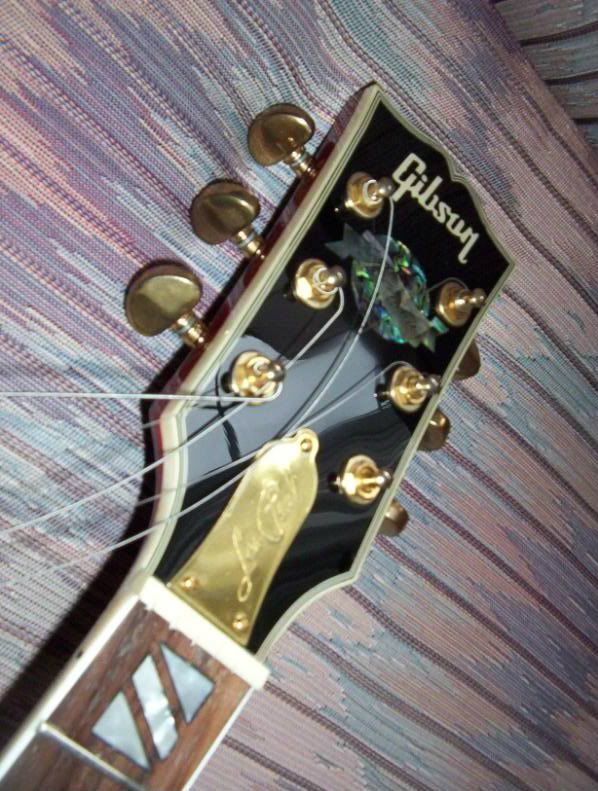
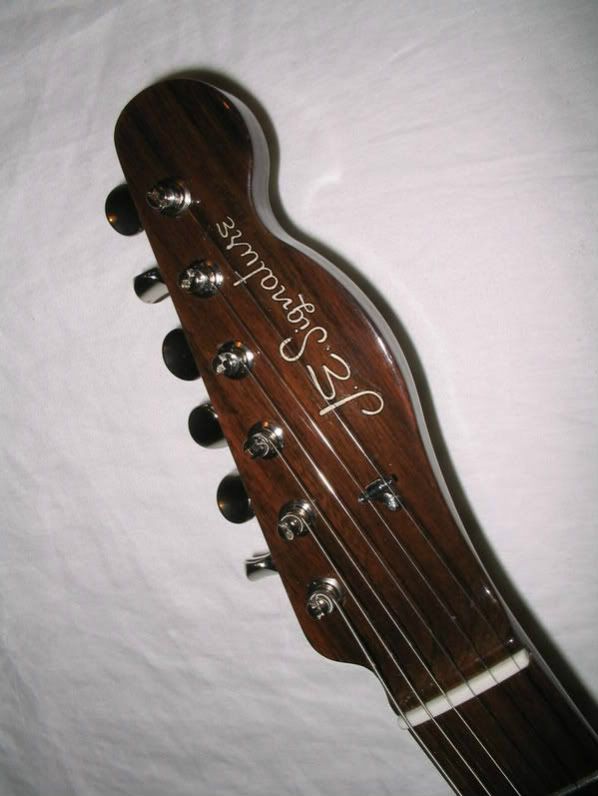
To first question: is not an easy operation and it is not a difficult operation. If in doubt, I would take it to a trusted luthier. Any guitar with the name Les Paul on it, whoever makes it, is a valuable and cherished instrument, and it should be taken care of as best as possible and it should be performing to maximum potential. We want to avoid loss or damage therefore.
It is much like an acoustic guitar's nut, and not at all like a Fender nut, which is a mere slice of material, unglued, that you can knock or tap through with a fine, fine punch or 'nail setter' (woodworker's tool?) and with the precise use of a hammer.
I believe that my Les Paul nuts have been glued in. You can try and see if yours is loose with strings off, but I don't think so - you would have have told us. Most Les Pauls from some modern day to the present have a plastic or delrin-type headstock face, and the older ones were a veneer of wood, other than the maple that was most-used in the neck. It can break or chip, or similarly the rosewood/ebony fretboard can splinter when any traumatic force is applied. You would also have to take the precaution to cut the lacquer or any glue that is present on the sides of the nut, by scoring it with an X-acto knife or hobby knife, like a scalpel, to prepare it for loosing. Then, we take a thin piece of wood like a ruler or paint stir stick and with our hammer, tap it out, or knock it down, toward end of headstock. Hope that the glue on the bottom breaks off cleanly, or it will pull some of the neck's wood with it. The bell shape truss rod cover must also be removed, and lets you look under the nut, to a point. Indeed, you might see a little glue and the condition of the wood below it. Check that, revealing this area.
Any new nut would have to be dressed, with larger slots cut for large gauge strings, that's tricky so that strings will not be hitched, and will ring true, and not sound like they are sitting on mush, like a sponge? Slots should be U-shaped, not sharp.
Second question, though I encourage others to add to the above, and resolve the issues with any video or written sites - there's always a chance that Dan Erlewine has covered it somewhere. Beware of just "any google" about changing a nut. Since it has been changing strings or gauges that affects your action, you need to tighten the truss rod. Coincidence: that goes well with changing a nut and should be done with a Gibson-type truss rod adjustment tool, and NOT a small socket. So, it calls for clockwise rotation and tightening the "rod", to act against the additional string pull. It's not really a bridge issue, except that thicker strings sit higher on the saddle, so the bridge can be adjusted down a tiny bit to compensate for that.
Oh, BTW, I said "rod" above to avoid any confusion, since it is a nut on the threaded rod that you tighten, not string's nut.
Good! You can do intonation. :D Okay, if you take it in for repair, they might do it, or leave it up to you. Good luck, Nuno!
Like a bird on the wire,
like a drunk in a midnight choir
I have tried in my way to be free.
First of all, thank you very much for your deep and long reply! I will read it again at home but I think I will not remove the nut. The string is in the slot and I think it is "fixed", I mean it can not slip. I will try to post a picture.
A friend recommended to me a very good luthier a couple of years ago. Probably I will ask him for changing the nut. And perhaps the electronics, I always wanted to change those pots. Lately I am playing a lot that guitar and every day I remember why I bougth it five years ago.
Then, should I do the trust rod adjustment first? If so, I can do it. I already do it in my bass.
I did the old test of pressing the strings in the first and twelve frets and it seemed the trust rod was correct so I think of the bridge. I will do it again.
Anyway, thank you very much again! :D
You're welcome. Have a look at the amount of bow or dip in the neck, and see if that passes the "eye test". I know this is subjective, but if there is a lot of bow or dip that you can see, it is probably too much. I run my necks almost flat, but actually with minimal bow, only because all the rules state to keep a bit of bow in the neck. Then warm weather comes, my necks stretch out by themselves & almost go humped :shock:. I get "too low" action and either buzz or just a string collision with a fret, which stops the note from ringing and sustaining. So I am always loosening truss rods, of all models and description.
The bow increases with increased or stronger string pull, so I would tighten a little, not much, to counter the greater force.
Yes, I am sure that you should adjust your bridge too, and have asked, or elected to do it wisely. That's very good! We don't usually think of bridge adjustment when the heavier strings are producing higher action, but as we've covered, the strings do sit a little higher because they're just fatter! So, turn thumbscrews counter clockwise when there is reduced or slackened tension, tune up, and see if you like it, no buzzes in the uppermost frets or registers, and you're good to play on and enjoy.
Here's a nut that I like though it is very old, 1984, still works good with strings (10 - 46) fitting fairly flush in their grooves.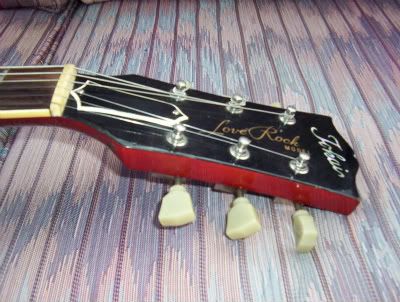
Action along the neck, and neck bow: your trained eye can tell that action is pretty low, especially in the first frets near the nut, and you may not see the actual bow or downward dip in the fingerboard, but I get most relief between frets 7 and 12, then low again. This is personal preference again, but my TOM bridge is a little higher on the bass side, yet still fairly low?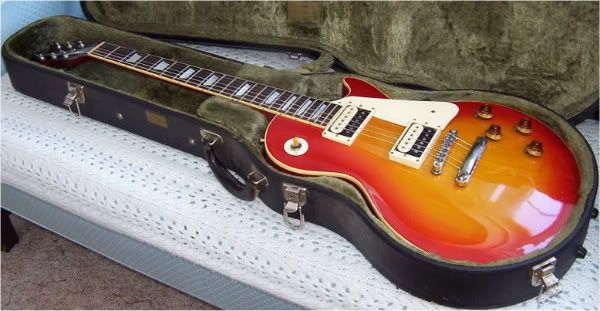
Hopefully, you can really see it here, looking at both E strings and not the glare; a gradual or soft, smooth bow frets 5 - 14.
Oh, I have just re-considered, perhaps the height then sag of the glare in relation to the gold strings shows degree of bow?
It could also show the angle or pitch of the neck, but there is none. It's flat, parallel to the body & rises again at the uppers. I say things differently but try to illustrate - I think of the neck like a plank or a shelf, weighed down, load in the middle. :lol: 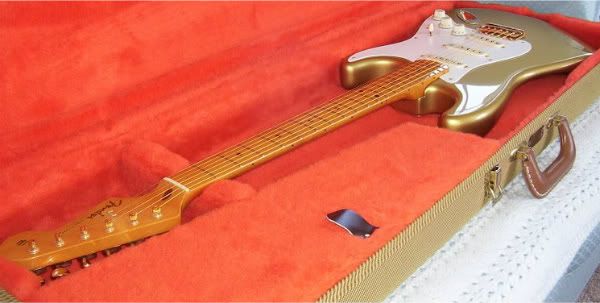
Like a bird on the wire,
like a drunk in a midnight choir
I have tried in my way to be free.
Nice collection of pics!
I reviewed the neck and it has just a little bit of bow. Yesterday I only had a look at the neck and I pressed the strings with my fingers but today I followed the procedure that a friend of mine showed me some years ago. I used a capo on the 1st fret and pressed the strings around the 14th fret (I did it until the 22th). The strings do not touch the frets but they are able to maintain a business card.
Then, I adjusted slightly the bridge, just 3/4 of turn in each screw. It is enough. It is comfortable to me. I tuned again and also repeated the test with the business card. The low E is slightly higher than the high E but it is Ok according the manual and Gibson recommendations.
The nut is another issue. I will wait, it seems it is working properly. Tomorrow I will post some pics. (It is late here!)
Thank you! :D
Here's a couple of short articles on the subject of nut replacement (one of which is by the aforementioned Dan Erlewine)
http://www.stewmac.com/tsarchive/ts0063.html
http://www.stewmac.com/tsarchive/ts0035.html
They may not go into enough depth to serve as a "first timer's guide", but they show the steps, and might let you judge if you have the skills to take on the project yourself.
And, yes, they are advertisements for StewMac's tools. You can use more general purpose tools in many cases.
I wrapped a newspaper ’round my head
So I looked like I was deep
Might be worth a try.
I'd use a super-glue (Cyanoacrylate) and use only a small amount.
Do it in a well ventilated area.
Obviously, take the string off first. :wink:
I wrapped a newspaper ’round my head
So I looked like I was deep
If you do use super-glue, here's a tip for you.
When you think that the glue has set in the joint, put a few of drops of water into the nut slot. The water will cause any glue that has seeped out to go hard. It will save you the embarrassment of supergluing the low E string into place.
I started with nothing - and I've still got most of it left.
Did you know that the word "gullible" is not in any dictionary?
Greybeard's Pages
My Articles & Reviews on GN
Ok, thanks! I'll do.
I build models (plastic and wooden). The cyanoacrylate is good for this things but perhaps it could be used one of those "chemical" glues. Lately I am using a glue by Humbrol for the plastic models. It is good for styrene but I am not sure if it will able to join the plastic of the nut.
And also thanks for the tip about the drops of water. I didn't know it!
Humbrol glue works by melting the styrene, effectively welding the parts together.
As a glue it doesn't seem to work very well with other materials - it seems pretty much a one-trick pony.
I started with nothing - and I've still got most of it left.
Did you know that the word "gullible" is not in any dictionary?
Greybeard's Pages
My Articles & Reviews on GN
I wouldn't expect the nut to be made of something as soft as styrene. That would absolutely kill the string vibration.
Generally nuts are made of a hard material.
According to a bit of googling:
Starting in the '70s, Gibson made nuts and saddles of Nylon 6/6. Type 6/6 Nylon 101 is the most common commercial grade of Nylon and its natural color is off-white, and is quite a dense form of nylon.
The solvent for nylon in general seems to be formic Acid, which sounds like a really bad idea to tinker with.
Cyanoacrylate is suggested for gluing nylon to itself or other things.
I wrapped a newspaper ’round my head
So I looked like I was deep
Done. I used cyanoacrylate. It is drying now. Tomorrow I will put the string again.
I will try to do the slot wider. Could I the string or it is better to used a file or sandpaper? In stewmac.com they use a special saw. I could also use small drill bits (Dremel)...
Keep you informed...
Try sandpaper folded. You want wider and not much deeper. I mean, deeper is not the goal, but is okay for a 52 string.
I think that using a Dremel or drill bit will spread it and break it in another spot that may not be fixable in this instance.
Like a bird on the wire,
like a drunk in a midnight choir
I have tried in my way to be free.

